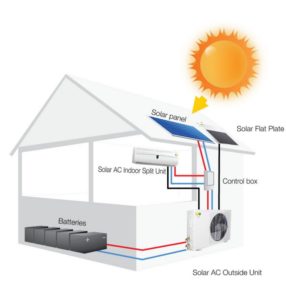What is a Solar Air Conditioner?

Solar Air Conditioning is an air conditioning system (cooling and heating) that uses solar energy to operate.
How this technology saves energy: The system of the flat solar dish absorbs the infrared rays, as well as other radiations of the sun. This flat solar dish then becomes hot internally and thereby heats the cooling gas when it passes through it. In turn, the refrigerant gas has thermal energy. This process increases the internal energy of the refrigerator molecules. These move with a higher kinetic energy value (higher velocity) than previously. The gas molecules collide with each other and jump with higher energies. This weakens the intermolecular forces and the molecules move further away, which then results in an increase in volume.
At this point, most if not all the pressure produced by the additional heat is released in mass volume flow and therefore substantially increases the molecular velocity of the refrigerant gas. This results in an increase in the temperature difference between the condensing and ambient temperatures, leading to an increase in the surface area of the condenser.
The Condenser Process:
The system condenser is designed to manage the compressor operation at full load. During full sun (when a conventional air conditioner works at full load), the condenser process in a solar air conditioner will ensure that the compressor will virtually never run at full load. Flat plate heat uses heat (temperature only) by increasing the kinetic energy of the gas molecules, thereby increasing the mass volume flow, and also creating an improved Delta T, thereby in fact increasing the efficiency of the heat exchanger (Condenser) in a solar air conditioner.

